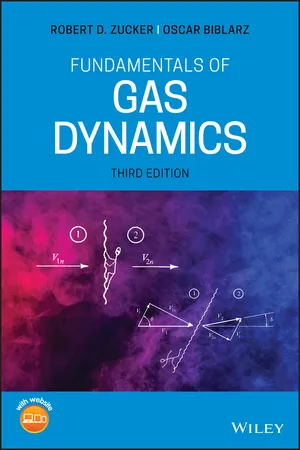
- English
- ePUB (mobile friendly)
- Available on iOS & Android
Fundamentals of Gas Dynamics
About This Book
New edition of the popular textbook, comprehensively updated throughout and now includes a new dedicated website for gas dynamic calculations
The thoroughly revised and updated third edition of Fundamentals of Gas Dynamics maintains the focus on gas flows below hypersonic. This targeted approach provides a cohesive and rigorous examination of most practical engineering problems in this gas dynamics flow regime. The conventional one-dimensional flow approach together with the role of temperature-entropy diagrams are highlighted throughout.
The authors—noted experts in the field—include a modern computational aid, illustrative charts and tables, and myriad examples of varying degrees of difficulty to aid in the understanding of the material presented. The updated edition of Fundamentals of Gas Dynamics includes new sections on the shock tube, the aerospike nozzle, and the gas dynamic laser. The book contains all equations, tables, and charts necessary to work the problems and exercises in each chapter. This book's accessible but rigorous style:
- Offers a comprehensively updated edition that includes new problems and examples
- Covers fundamentals of gas flows targeting those below hypersonic
- Presents the one-dimensional flow approach and highlights the role of temperature-entropy diagrams
- Contains new sections that examine the shock tube, the aerospike nozzle, the gas dynamic laser, and an expanded coverage of rocket propulsion
- Explores applications of gas dynamics to aircraft and rocket engines
- Includes behavioral objectives, summaries, and check tests to aid with learning
Written for students in mechanical and aerospace engineering and professionals and researchers in the field, the third edition of Fundamentals of Gas Dynamics has been updated to include recent developments in the field and retains all its learning aids.
The calculator for gas dynamics calculations is available at www.oscarbiblarz.com/gascalculator
Frequently asked questions
Information
Chapter 1
Definitions and Fundamental Principles
1.1 INTRODUCTION
1.2 UNITS AND NOTATION
- Dimension: a qualitative definition of a physical entity (such as time, length, force)
- Unit: the appropriate magnitude of a dimension (such as seconds, feet, newtons)
| Dimension | Basic Unit Used | |
| English Engineering (EE)a | International System (SI) | |
| Time | second (sec) | second (s) |
| Length | foot (ft) | meter (m) |
| Force | pound force (lbf) | newton (N) |
| Mass | pound mass (lbm) | kilogram (kg) |
| Temperature | Fahrenheit (°F) | Celsius (°C) |
| Absolute Temperature | Rankine (°R) | kelvin (K) |
Table of contents
- Cover
- Table of Contents
- Preface to Third Edition
- Preface to Second Edition
- To the Student
- About the Companion Website
- Chapter 1: Definitions and Fundamental Principles
- Chapter 2: Control Volume Analysis—Part I
- Chapter 3: Control Volume Analysis—Part II
- Chapter 4: Introduction to Compressible Flow
- Chapter 5: Varying‐Area Adiabatic Flow
- Chapter 6: Standing Normal Shocks
- Chapter 7: Moving and Oblique Shocks
- Chapter 8: Prandtl–Meyer Flow
- Chapter 9: Fanno Flow
- Chapter 10: Rayleigh Flow
- Chapter 11: Real Gas Effects
- Chapter 12: Propulsion Systems
- Appendix A: Summary of the English Engineering (EE) System of Units
- Appendix B: Summary of the International System (SI) of Units
- Appendix C: Friction‐Factor Chart
- Appendix D: Oblique‐Shock Charts (γ = 1.4) (Two‐Dimensional)
- Appendix E: Conical‐Shock Charts (γ = 1.4) (Three‐Dimensional)
- Appendix F: Generalized Compressibility Factor Chart
- Appendix G: Isentropic Flow Parameters (γ = 1.4) (Including Prandtl–Meyer Function)
- Appendix H: Normal‐Shock Parameters (γ = 1.4)
- Appendix I: Fanno Flow Parameters (γ = 1.4)
- Appendix J: Rayleigh Flow Parameters (γ = 1.4)
- Appendix K: Properties of Air at Low Pressure
- Appendix L: Specific Heats of Air at Low Pressures
- Selected References
- Answers to Problems
- Index
- End User License Agreement